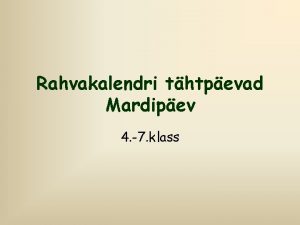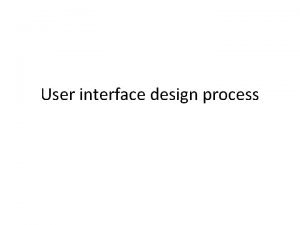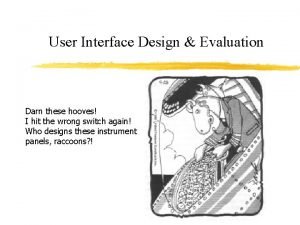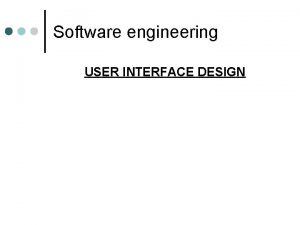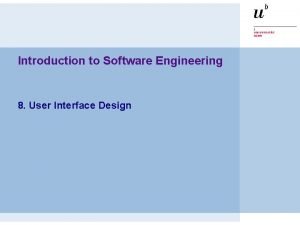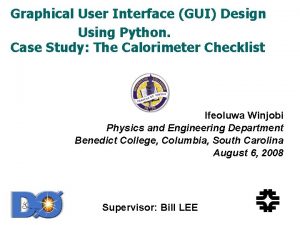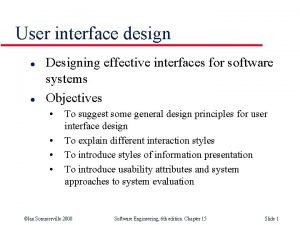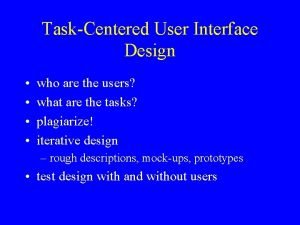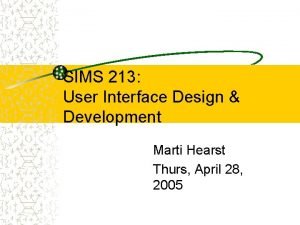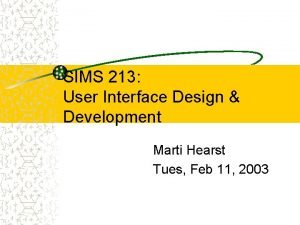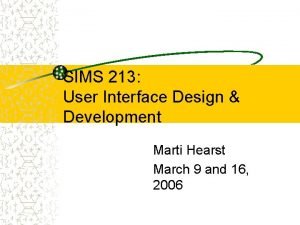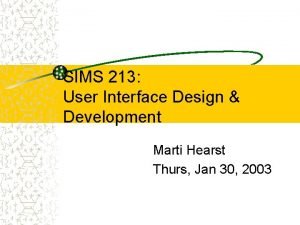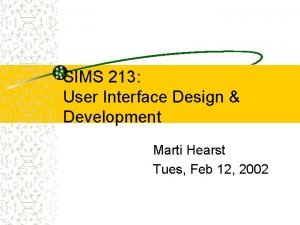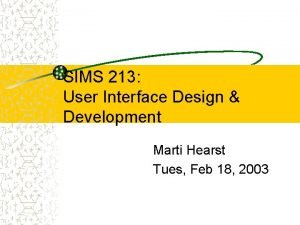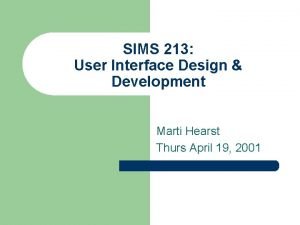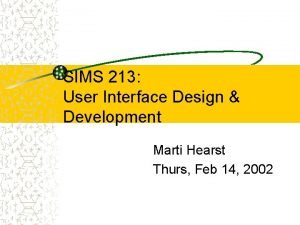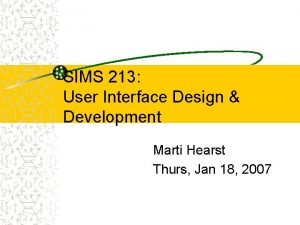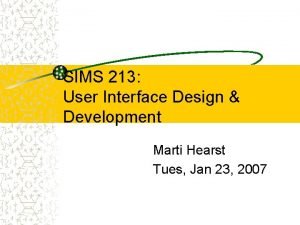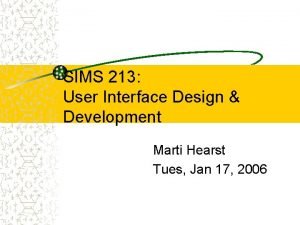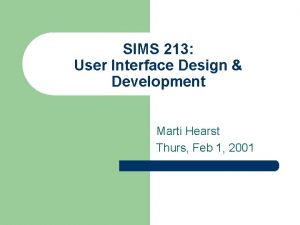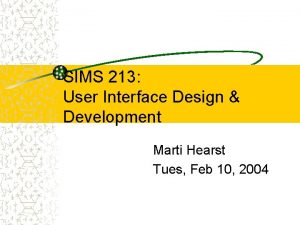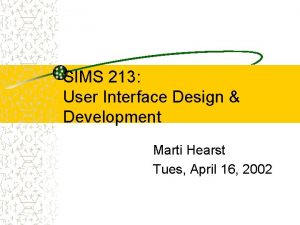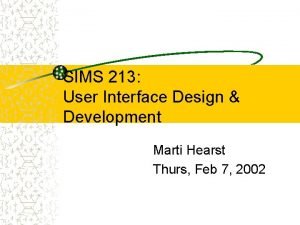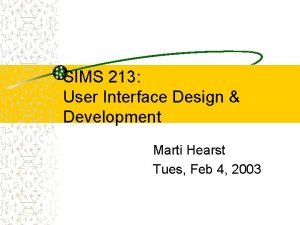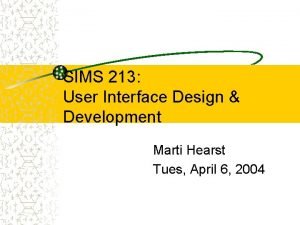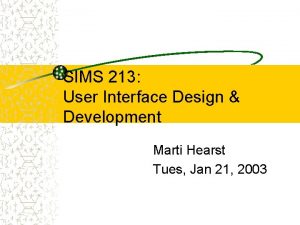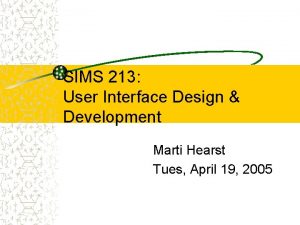SIMS 213 User Interface Design Development Marti Hearst




















- Slides: 20

SIMS 213: User Interface Design & Development Marti Hearst Tues, Feb 1, 2005

Today Finish Task Analysis example Personas

Task Analysis Characterize what happens when users perform typical tasks Tools: – table of user communities vs. tasks • Who x What – table of task sequences – flowchart or transition diagram – videotape depicting scenario Slide adapted from Ben Shneiderman

User-centered Design Example Interview Questions & Summary Results

How Often Do Users Perform the Tasks? Frequent users remember more details Infrequent users may need more prompting Which function is performed – most frequently? – by which users? – optimize system for tasks that will improve perception of its performance Slide adapted from James Landay's

User-Centered Design Example Task Analysis Table

User-Centered Design Example Task Analysis Table

Augment Table with Percentages (What percentage of the is this task done by this person) (Numbers are only suggestive, adapted from Shneiderman 98)

User-Centered Design Example The next step: – Use Task Matrix to Create Scenarios – Scenarios indicate the sequence of steps the personas go through to complete certain tasks A more recent development – First create Personas – Use these to create Scenarios

Cooper on Designing for Goals We do tasks to achieve goals – don’t equate them! – Traveling safely in 1849 vs. 1999 Goal of good design: help users achieve practical goals while not violating their personal goals – No “unnatural acts” Distinctions: – Personal goals – Corporate goals – Practical goals

Think Outside-in versus Inside -out Do not expect others to think or behave – as you do – as you would like them to Assess the meaning of the displays and controls based on what a user can be assumed to know, not based on what you know

Example: Playing Pictionary Getting into someone else’s head

Observation (from Cooper) Being a victim of a problem does not necessarily bestow the power to see the solution An individual is not always representative – Company president example

Personas (from Cooper) “Hypothetical Archetypes” – Archetype: (American Heritage) • An original model or type after which other similar things are patterned; a prototype • An ideal example of a type; quintessence A precise description of a user and what they want to accomplish – Imaginary, but precise – Specific, but stereotyped • Real people have non-representative quirks

The Essence of Personas Describe a person in terms of their – Goals in life (especially relating to this project) – Capabilities, inclinations, and background People have a “visceral” ability to generalize about real and fictional people – We can have detailed discussions about what Harry Potter, Scarlett O’Hara, or Colin Powell will think or do. – They won’t be 100% accurate, but it feels natural to think about people this way

Reasons for Personas A compromise design pleases no-one – The broader you aim, the more likely you miss the bulls-eye – 50% of the people 50% happy doesn’t work • Car example – soccer mom, carpenter, dot-com exec – “Every time you extend functionality to include another constituency, you put another speed bump of features and controls across every other user’s road. ” A targeted design can achieve – 10% people 100% ecstatic – Examples: • Ram pickup truck

Reasons for Personas Examples of results of targeted design – Dodge Ram pickup – Roller suitcases – Sony Aibo • Isn’t useful for anything • Not fuzzy and warm • Too delicate to let children use it, but – Passionate fan clubs – Brisk sales despite steep price – and prices now coming down

Reasons for Personas Avoid the “elastic user” – If the description is not specific, it can easily wiggle to suit the design needs of the moment Piston analogy Helps prevent designer / programmer from imagining they are the user Image from www. howstuffworks. com

Reasons for Personas Puts an end to feature debates – Makes hypothetical arguments less hypothetical • Q: “What if the user wants to print this out? ” • A 1: “The user won’t want to print often. ” • A 2: “Emilee won’t want to print often. ” User Persona, not Buyer Persona – This is one way HCI differs from marketing – Eventually it pays off in more sales

Next Time Practice Persona development Holtzblatt on Task Analysis
 Marti a. hearst
Marti a. hearst Marti hearst
Marti hearst Mardipäeva ilmaennustus
Mardipäeva ilmaennustus User interface design in system analysis and design
User interface design in system analysis and design Input output form
Input output form Graphical user interface design principles
Graphical user interface design principles User interface design cycle
User interface design cycle User interface design steps in software engineering
User interface design steps in software engineering User interface analysis and design
User interface analysis and design Graphical user interface design principles
Graphical user interface design principles Cognitive walkthrough vs heuristic evaluation
Cognitive walkthrough vs heuristic evaluation Atm ui design
Atm ui design User interface design and evaluation
User interface design and evaluation What is user interface design in software engineering
What is user interface design in software engineering User interface design principles in software engineering
User interface design principles in software engineering Python gui design
Python gui design Visualization in user interface design
Visualization in user interface design Recoverability in user interface design
Recoverability in user interface design Interface analysis means understanding
Interface analysis means understanding Task centered user interface design
Task centered user interface design User interface design in software engineering
User interface design in software engineering


